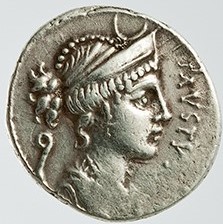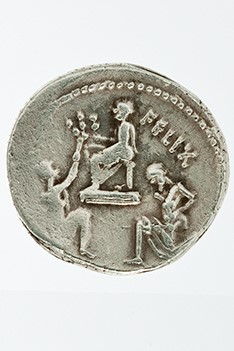Acquisition number: 1967.14
Obv.: Bust of Diana r., diademed, with jewelled hair, wearing necklace and earring. Above, crescent. On left, lituus (augur's staff) on right, FAVSTVS (downwards). Border of dots.
Rev.: Sulla seated l. on raised seat. Before him Bocchus kneels, r., offering olive–branch in right hand. Behind, Jugurtha (bearded) kneels, l., hands tied behind back. On right, FELIX (downwards). Border of dots.
Title: Denarius of Faustus Sulla - 1967.14
Acquisition number: 1967.14
Author or editor: Beryl Rawson
Culture or period: Roman Republic
Date: 56 BC
Material: Metal - Silver
Object type: Coins - Roman
Dimensions: 18mm (w)
Origin region or location: Italy
Origin city: Rome
Display case or on loan: 5
Keywords: Coin, denarius, Roman, Republic, Diana, Sulla
Sear, D.R., Roman Coins and their Values 5 vols (London, Spink, 2000-2014) 383; Crawford, M., Roman Republican Coinage 2 vols (Cambridge, Cambridge University Press, 2011) 426/1 and pl. LI; Sydenham, E. A. The Coinage of the Roman Republic (London, Spink, 1952; (Sanford J. Durst repr. 1976) 879 and pl. 24; Seaby, H.A., Roman Silver Coins (London, B.A. Seaby, 1967) Cornelia 59; Grueber, H.A., Coins of the Roman Republic in the British Museum 3 vols (London, The Trustees of the British Museum, 1910; rev. edn London, 1970) I. 3824.
1967.14
Denarius of Faustus Sulla
3.952 g. 56 BC
Obv.: Bust of Diana r., diademed, with jewelled hair, wearing necklace and earring. Above, crescent. On left, lituus (augur's staff) on right, FAVSTVS (downwards). Border of dots.
Rev.: Sulla seated l. on raised seat. Before him Bocchus kneels, r., offering olive–branch in right hand. Behind, Jugurtha (bearded) kneels, l., hands tied behind back. On right, FELIX (downwards). Border of dots.
This coin glorifies the dictator Sulla (now dead), and indirectly his son Faustus (born a little before 86 BC). As Sulla took on the extra name ‘Felix’ (= successful, fortunate) late in life (c. 82 BC), its application here, in connection with a much earlier incident, is not strictly accurate. But the incident could be seen as an example of Sulla’s intrinsic good fortune: in 105 BC, as one of Marius’ officers in Africa, he managed the delicate and dangerous business of getting Bocchus (king of Mauretania) to betray and surrender Jugurtha (king of Numidia and son-in-law of Bocchus) to him. This achieved the end of Rome’s war with Jugurtha, and Marius (as commander-in-chief) celebrated a triumph for the victory, but Sulla publicised his own role, for personal propaganda purposes. He had the scene of the surrender set in the seal of his ring, and no doubt encouraged Bocchus to set up on the Capitol in Rome gilded statues representing the same scene. Marius was angered by this pro-Sullan propaganda. (See Plutarch, Marius 32, Sulla 6.)
Diana was one of Rome’s oldest goddesses. She was also one of those who received Sulla’s special devotion.
The augur was one of the prestigious priests responsible for divining the will of the gods. Sulla senior had been an augur, and Faustus Sulla was also an augur by 57 BC.
This coin is of superior artistic quality. It may have been issued by Faustus immediately after his return from service in the East under Pompey, in 62 BC, or in the year when he gave lavish games in honour of his father’s memory, 60 BC. In either case he probably used some of his extensive Eastern booty for this purpose. Crawford dates the coin to 56 BC on the grounds that the lituus refers to Faustus’ augurate and that his moneyership should be not more than two years before his quaestorship (54 BC).
This is one of the series of Republican coins restored by the emperor Trajan early in the second century AD. Trajan attempted to show the continuity of Roman history, and his own place in it, by reviving Republican coins commemorating important incidents and personalities. (Cf. 66.77.)
Harlan dates this to 55 BC. [Michael Harlan, Roman Republican Moneyers and Their Coins 63BC – 49 BC, Seaby B. T. Batsford Ltd, London, 1995, pp. 100-103.]
Sear, D.R., Roman Coins and their Values 5 vols (London, Spink, 2000-2014) 383; Crawford, M., Roman Republican Coinage 2 vols (Cambridge, Cambridge University Press, 2011) 426/1 and pl. LI; Sydenham, E. A. The Coinage of the Roman Republic (London, Spink, 1952; (Sanford J. Durst repr. 1976) 879 and pl. 24; Seaby, H.A., Roman Silver Coins (London, B.A. Seaby, 1967) Cornelia 59; Grueber, H.A., Coins of the Roman Republic in the British Museum 3 vols (London, The Trustees of the British Museum, 1910; rev. edn London, 1970) I. 3824.

